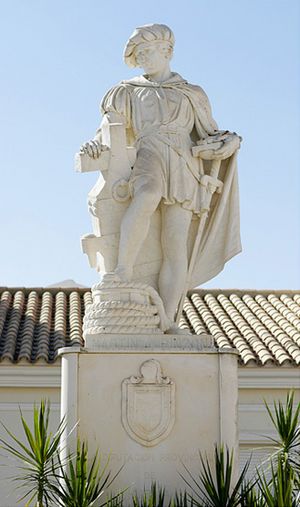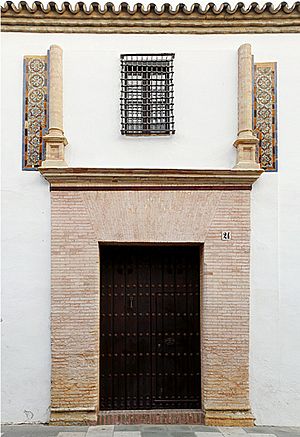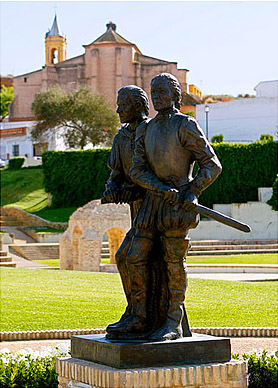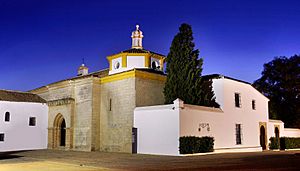Martín Alonso Pinzón facts for kids
Martín Alonso Pinzón (born around 1441, died around 1493) was a famous Spanish sailor and explorer. He was the oldest of the Pinzón brothers, who were well-known mariners. Martín Alonso Pinzón sailed with Christopher Columbus on his very first trip to the New World in 1492. He was the captain of the ship called the Pinta. His younger brother, Vicente Yáñez Pinzón, was the captain of the Niña. Their middle brother, Francisco Martín Pinzón, was the first mate on the Pinta.
Contents
The Pinzón Family: Famous Sailors
The Pinzón family was one of the most important families in Palos de la Frontera, Spain, during the late 1400s. They were known for their skills at sea. Martín Alonso Pinzón's father was also a sailor named Martín Pinzón. His mother was named Mayor Vicente.
Martín Alonso Pinzón's Early Life
Martín Alonso Pinzón was born in Palos around 1441. It seems he started sailing at a young age, perhaps as a cabin boy on a local ship. His home, which is now a museum, was on the old road to the Monastery of La Rábida. Martín married a woman named María Álvarez. They had five children: two sons, Arias Pérez and Juan, and three daughters, Mayor, Catalina, and Leonor. Both of his sons later joined expeditions to the Americas.
Martín Alonso Pinzón was a very experienced sailor. He was known for his voyages to the Canary Islands and Guinea, where people traded for gold, spices, and other goods. He also fought against the Portuguese in sea battles.
Helping Columbus Prepare for His Voyage
In 1492, Queen Isabella and King Ferdinand of Spain ordered the town of Palos to provide ships and sailors for Christopher Columbus's journey. However, the local sailors were not eager to go. Columbus was not well-known to them, and the trip seemed very risky with uncertain rewards.
Around this time, Pinzón returned from a trading trip. The monks at the Monastery of La Rábida helped Columbus connect with Pinzón. A respected old sailor named Pero Vázquez de la Frontera also encouraged Pinzón to support Columbus.
Martín Alonso Pinzón decided to help Columbus. He even invested a large amount of his own money, about half of what the King and Queen put in. Because he was a respected shipowner and expert sailor, he was able to find a good crew. He chose two of his own ships, the Pinta and the Niña, because he knew they were strong and suitable for the long journey. He traveled through nearby towns, convincing his relatives and friends to join the expedition. Witnesses later said he worked very hard to get people to sign up, as if the discoveries would be for him and his family.
At this time, Pinzón and Columbus seemed to be good friends. One witness recalled hearing Columbus promise Pinzón that if they found new lands, he would treat him "as a brother."
The Great Voyage with Columbus
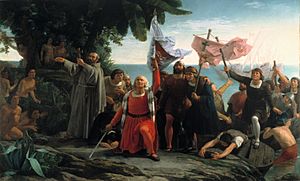
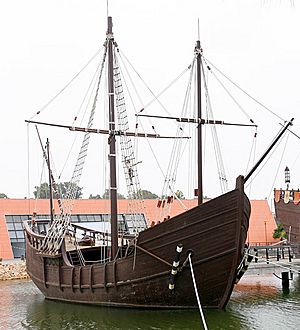
Setting Sail for the New World
On August 3, 1492, the three ships—the Santa María, the Pinta, and the Niña—left Palos. Columbus was the captain of the Santa María. Pinzón was the captain of the Pinta, and his brother Francisco was the first mate. It was from the Pinta that a sailor named Rodrigo de Triana first spotted land in the Americas.
During the journey, Pinzón showed his great skills as a sailor and a leader. When the crew of the Santa María became tired and discouraged, Pinzón helped Columbus keep everyone motivated. Pinzón also suggested a change in course on October 6, 1492. This change led the expedition to land on Guanahani (an island in the Bahamas) on October 12, 1492.
Many historians believe that the Pinzón brothers were "co-discoverers of America." This is because without their help, support, and bravery, Columbus might not have been able to complete his journey of discovery.
Separation in the Caribbean
At first, Columbus and Pinzón got along well. But once they reached the Caribbean islands, things started to change. On November 21, 1492, near Cuba, Pinzón did not follow Columbus's direct order to change course. He likely sailed off on his own to explore and search for treasure. During his separate travels, he discovered new land, which is believed to be part of Haiti.
On December 25, the Santa María was wrecked on a sandbar. Pinzón's brother Vicente, captain of the Niña, played a key role in rescuing the sailors and Columbus. Columbus then started sailing home on January 4, leaving 38 men behind. The Niña and Pinta met again on January 6, 1493. After a heated discussion, the two ships headed back to Spain together on January 8.
Return Voyage and Death
On the way back to Spain, Pinzón's ship, the Pinta, got separated from Columbus's ship during a storm near the Azores. Pinzón arrived in Baiona, Spain, on March 1, 1493. Columbus reached Lisbon, Portugal, on March 4. Pinzón managed to land on Spanish territory, not Portuguese, despite the bad weather.
Believing Columbus might be lost, Pinzón sent a letter to the King and Queen. Some people say he tried to claim the glory of the discoveries for himself, while others defend him. The letter itself is now lost. In any case, the royal court told him to only come under Columbus's command.
Pinzón returned home to Palos on March 15, 1493, the same day the Niña arrived. He was very tired and suffering from a fever. He was carried off his ship on a stretcher. It is believed he was taken to the La Rábida Monastery, where he died. He was buried there, as he had wished.
See also
 In Spanish: Martín Alonso Pinzón para niños
In Spanish: Martín Alonso Pinzón para niños


